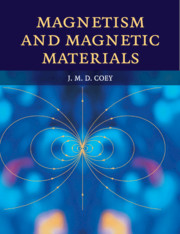Book contents
- Frontmatter
- Contents
- List of tables of numerical data
- Preface
- Acknowledgements
- 1 Introduction
- 2 Magnetostatics
- 3 Magnetism of electrons
- 4 Magnetism of localized electrons on the atom
- 5 Ferromagnetism and exchange
- 6 Antiferromagnetism and other magnetic order
- 7 Micromagnetism, domains and hysteresis
- 8 Nanoscale magnetism
- 9 Magnetic resonance
- 10 Experimental methods
- 11 Magnetic materials
- 12 Applications of soft magnets
- 13 Applications of hard magnets
- 14 Spin electronics and magnetic recording
- 15 Special topics
- Appendices
- Formula index
- Index
- Tables, conversions, constants and units
10 - Experimental methods
Published online by Cambridge University Press: 05 June 2012
- Frontmatter
- Contents
- List of tables of numerical data
- Preface
- Acknowledgements
- 1 Introduction
- 2 Magnetostatics
- 3 Magnetism of electrons
- 4 Magnetism of localized electrons on the atom
- 5 Ferromagnetism and exchange
- 6 Antiferromagnetism and other magnetic order
- 7 Micromagnetism, domains and hysteresis
- 8 Nanoscale magnetism
- 9 Magnetic resonance
- 10 Experimental methods
- 11 Magnetic materials
- 12 Applications of soft magnets
- 13 Applications of hard magnets
- 14 Spin electronics and magnetic recording
- 15 Special topics
- Appendices
- Formula index
- Index
- Tables, conversions, constants and units
Summary
Why think? Why not try the experiment?
John Hunter 1728–1793Central to most magnetic measurements is the generation and detection of magnetic fields. Atomic-scale magnetic structure is best probed by neutron diffraction, while other atomic-scale element-specific information is provided by spectroscopic methods. Domain-scale magnetization measurements are made by magneto-optic methods or magnetic force microscopy, whereas macroscopic measurements of magnetization are made in open or closed circuit by a variety of methods. Spin-wave and other excitations are best explored by inelastic neutron scattering. Numerical methods of investigation are of growing importance for understanding the static and dynamic behaviour of real magnetic materials and magnetic systems.
Magnetism is an experimental science. Experiments serve to inspire and refine physical theory, besides providing all the quantitative information on which the applications depend. The traditional image of apparatus on a laboratory bench does not tell the whole story; some magnetic measurements are now conducted at national or multinational institutes built around large-scale facilities for generating high magnetic fields, neutron beams or intense streams of synchrotron radiation. Computers have evolved in the opposite sense, from central facilities to benchtop instruments for data acquisition, display and modelling. Numerical computations and simulations may be regarded as an experimental tool for investigating a model reality, where complex magnetic behaviour at the atomic, micromagnetic or system level can be investigated with the aid of a computer workstation.
- Type
- Chapter
- Information
- Magnetism and Magnetic Materials , pp. 333 - 373Publisher: Cambridge University PressPrint publication year: 2010
- 1
- Cited by

